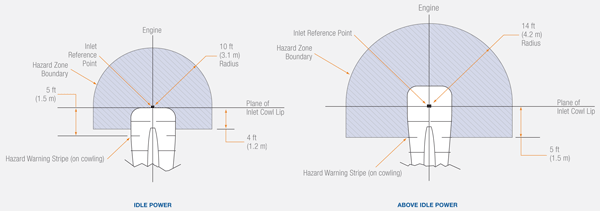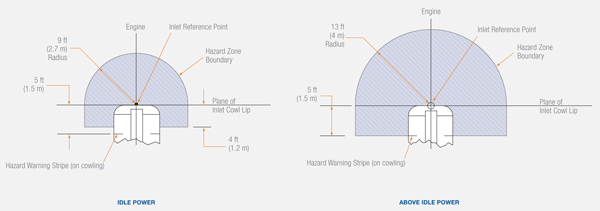
HIGHLIGHTING THE HAZARD
Preventing engine ingestion starts with ensuring that people who work around airplanes are aware of the dangers associated with getting too close to an operating engine. There are four primary ways to highlight these dangers:
- Clearly define and graphically illustrate the engine inlet hazard zone.
- Use recommended warning signs.
- Communicate the dangers of working near operating engines and institute and enforce safe procedures.
- Implement a program of ongoing awareness.
Clearly define and graphically illustrate the engine inlet hazard zone. All ground personnel who work near airplanes need to know the locations of the engine inlet hazard zones with engines at idle and above idle thrust (see figs. 1 and 2). Definitions for these zones are published in the AMMs.
Ground personnel working near the power plant during engine operation must also be aware of the hazard-areas that are aft of the inlet cowl lip. This hazard-area extends completely around the outer diameter and to the forward end of the power plant. After the engine is stopped, workers should be sure the fan is stopped before going near the air inlet. Ground personnel should stay outside of the inlet hazard-areas for at least 30 seconds after the start lever is put in the “cutoff” position. Ground personnel should be informed of the start lever position through communication with the crew on the flight deck.
737-100/-200 AND 737-300/-400/-500
ENGINE INLET HAZARD ZONES
Figure 1
Engine inlet hazard zones for the 737-100/-200
and 737-300/-400/-500
at idle power (left)
and above idle power (right).
NEXT-GENERATION 737
ENGINE INLET HAZARD ZONES
Figure 2
Engine inlet hazard zones for the Next-Generation 737 at idle power (left) and above idle power (right).

[+] Enlarge


